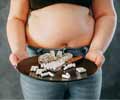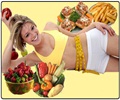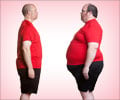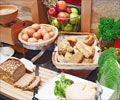About
Incomplete understanding of right eating misleads people and pushes them to adopt wrong practices that sideline healthy weight loss habits. Let’s revisit the most common myths about weight loss and learn the actual facts to counter the myths.
Myth 1: Weighing scale is an ideal indicator of weight loss

Reality: Frequent use of the weighing scale to judge weight loss does not give a true picture about your weight loss. Reduced weight on the scale may be indicative of either loss of water, muscle or fat. The loss of water and muscle from the body will give a false belief of having lost fat. This in turn has done more harm than good. Unknowingly the loss of muscle may in reality slow down the metabolic rate of the body and thereby reduce the rate of weight loss too. True weight status can only be gathered by tracking fat loss and not weight loss. The extent of fat loss can be obtained by getting a body composition analysis done at frequent intervals.
Myth 2: Over 50 and cannot exercise any more
Reality: People above 50 can easily exercise according to their choice, convenience and comfort. Exercise does not necessarily mean walking briskly or swimming or cycling but simple exercises like walking and yoga are enough. Once started, a person can eventually adopt a daily conscious exercise regime best suited to one’s time and comfort level. Exercise, however simple, can develop a positive outlook and improve quality of life. A personalized exercise regime can be constructed with the help of a fitness expert.
Myth 3: Weight loss products can be a quick solution to lose weight
Reality: As of date there is no product existing, which can reduce weight safely and keep it off permanently. Highly popularized and commercialized weight loss products and methods are neither scientific nor practical. Sometimes one does lose weight quickly when on a meal replacer, a fad diet or some pill, but this proves to be short lived and none are able to sustain the loss attained. Above all most tend to lose muscle and water than fat and thereby succumb to ill health rather than the aimed result.
Some procedures help in body toning but are highly expensive and to keep up with the figure attained, one has to ultimately resort to a standard toning exercise regime that again works on self motivation and hard work. Learning the correct eating principles and putting oneself to a regular exercise regime is the only solution to permanent fat loss and muscle gain. A slow and steady loss of 2 to 4 kilos a month is most preferred.
Myth 4: Conscious about inclusion of low fat foods in the daily diet, yet unable to lose weight
Reality: One may be eating less fat and taking in reduced percentage of calories from fat in the diet, but in totality the caloric intake may still be higher than the total calorie output. To meet the dietary goals one needs to watch the total caloric intake. The most effective way to keep the weight off is to stay active. Eating large portion sizes of food negates the efforts put in to control fat and sugar intake too. E.g. choosing to eat 4 to 5 bread slices over a small paneer paratha. So one should aim to eat small nutrient dense meals rather than big portions of caloric dense food. One should ponder upon nutrient density of food rather than just fat or caloric density.
Myth 5: Dairy products should be eliminated when on weight loss
Reality: One does not need to eliminate dairy products on a weight reducing diet, as they are the biggest source of calcium, required for various body functions. Dairy products are also rich in good quality protein and vitamin B, A and D, which is very essential for vegetarians. Above all protein rich foods facilitate fat loss. Therefore high fat dairy products should be replaced with their low fat alternatives as they still have the essential nutrients with fewer calories and traces of fat.
Myth 6: Potatoes, rice and bread are fattening
Reality: This is the biggest myth concerning weight loss. It’s the method of cooking and the high fat toppings or spreads that make certain food items fattening. One tablespoon of butter, ghee, margarine, or regular mayonnaise adds 100 calories. When food items such as potatoes, rice and bread are eaten in amounts recommended then they are as good as any other healthy food. However unlike wheat, millet they lack fiber and hence unpolished rice and authentic wheat bread are better options.
Myth 7: Eating fewer meals helps lose weight
Reality: Skipping meals and expecting to lose fat is the most foolish notion when trying to lose weight. It only results in a loss of energy, which eventually affects health and wellbeing. With fasting and long gaps between meals one tends to lose only muscles and water. It is advisable to eat protein foods like legumes, beans, egg whites and low fat milk to be thin and shapely. A complete change of lifestyle is what is needed in order to keep the weight off permanently.
Myth 8: Nuts are fattening
Reality: When on weight loss regime people tend to avoid nuts and dry fruits completely. It is common to think of them as fattening. But in reality nuts are rich sources of monounsaturated fats and vitamin E, K and Mg that are extremely beneficial for the heart. They are rich in protein and fiber too. Just a small quantity is highly satisfying and filling. Therefore 25 to 30 grams a day of mixed nuts (walnuts, peanuts, almonds, pecans) could constitute an extremely healthy snack food. Dry fruits like dates, raisin, fig, apricots could be an excellent substitute for fatty deserts and sweets.
Myth 9: Weight loss is impossible because of frequent tours
Reality: If one is eating out most of the time it is essential to know how to make the right choice. One must be able to analyze the ingredients of a dish and ask for modifications in the method of cooking or in the choice of ingredients. E.g. Ordering a salad without the dressing; selecting non cream based soups; choosing dals over gravy based vegetables; choosing plain wheat rotis over naans; choosing vegetable sandwiches over fat laden continental food.
One can resort to nuts, fruits, liquids, dairy products as snacks when on the go. Wherever you are, a conscious effort to eat less and light, balance a heavy meal with a lighter one and be physically active, would prevent weight gain and maintain sound digestion too.
Myth 10: Low fat food is always tasteless
Reality: There exists this biggest belief of low fat food being tasteless. Low oil cooking seems to be next to impossible for some people.
But in reality, foods prepared with less oil or fat can be as tasty as the standard preparation. By use of low fat curd based spreads, interesting dips, low fat milk instead of cream in gravies, paneer instead of butter, addition of nuts to salads, use of various curry powders, spices, and condiments, food can be made tastier minus the load of fat.
Choosing steamed snacks, healthy sandwiches, tasty whole grain snacks like popcorn, interesting stir fries, colorful fruit and vegetable salads, makes sense while on a weight loss regime.
Use of non stick cookware, oil sprays and cooking techniques like steaming, pressure cooking makes it all the more easier to prepare low fat healthy nutritious food. Once the health consciousness sets in one automatically becomes more creative with food modifications and is able to achieve perfect results in terms of nutrition and taste. This style of eating eventually becomes a way of life.













